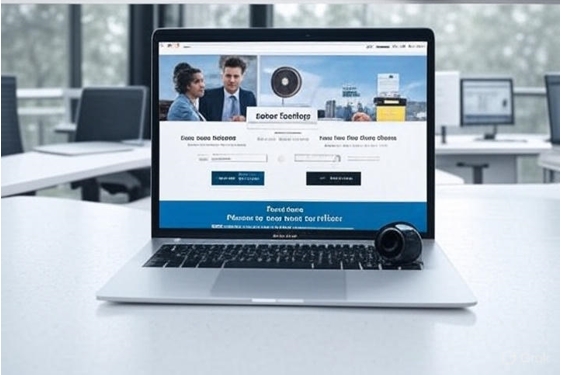Must-Have Features for Every Business Website
By Admin

While your business is undeniably your 24/7 storefront, brand ambassador, and lead generator, it will not meet the intended without the must-have business features.
With over 5.5 billion internet users globally, a well-designed website can make or break your ability to attract, engage, and convert customers.
But what separates a good website from a great one? It’s the essential website features that ensure seamless user experiences, boost credibility, and drive results.
Whether you’re a small business owner or a marketer, incorporating these business website must-haves can elevate your online success.
We explore 10 critical features every website needs—starting with user-friendly navigation and mobile-responsive design, to help you create a site that stands out and delivers value.
1. User-Friendly Navigation
Navigation is the backbone of a great user experience. If visitors can’t find what they need quickly, they’ll leave—potentially for a competitor’s site that’s easy to use. In fact, studies show that 94% of users cite easy navigation as a key factor in their trust of a website.
To make your site a breeze to explore, include these website elements for success:
- Clear Menu Structure: Keep menus simple, with 5–7 items max, using descriptive labels like “Home,” “Services,” or “Contact.” Avoid jargon or overly creative names that confuse users.
- Search Functionality: A search bar, ideally in the top-right corner, lets users find specific content instantly. Ensure it’s powered by a robust engine to handle queries effectively.
- Breadcrumbs: For deeper pages (e.g., product categories), breadcrumbs (like “Home > Shop > Electronics”) help users track their path and backtrack easily.
For example, take Amazon’s website: its clean menu, prominent search icon, and breadcrumb trails make browsing effortless, even with millions of products. Prioritizing intuitive navigation ensures visitors stay longer and engage more, setting the foundation for a successful website.
2. Mobile-Responsive Design
With over 60% of global web traffic coming from mobile devices in 2025, a mobile-responsive design isn’t optional—it’s a necessity. A site that doesn’t adapt to smartphones and tablets risks high bounce rates, as 53% of mobile users abandon pages that take over 3 seconds to load.
To nail this best website functionality, focus on these features:
- Responsive Layouts: Use flexible grids and CSS media queries to ensure your site adjusts seamlessly to any screen size, from iPhones to tablets.
- Fast-Loading Mobile Pages: Optimize images (e.g., use WebP format) and consider Accelerated Mobile Pages (AMP) to boost speed. A CDN (Content Delivery Network) can also reduce load times globally.
- Touch-Friendly Design: Ensure buttons and links are large enough for easy tapping, with at least 48x48 pixels and sufficient spacing to prevent misclicks.
For instance, Shopify’s website exemplifies mobile responsiveness, with its clean layout, quick load times, and thumb-friendly buttons.
A mobile-optimized site not only improves user satisfaction but also boosts SEO, as Google prioritizes mobile-friendly sites in rankings. Ideally, you cater to the majority of your audience and keep them coming back if you prioritize mobile-friendliness.
3. Fast Loading Speed/ Google Approved Speed
Page speed is a make-or-break factor for user retention and search engine rankings in 2025—and this will continue for a long time. According to Google, a 1-second delay in load time can reduce conversions by up to 20%.
With users expecting pages to load in under 2 seconds, fast loading speed is a business website must-have that impacts both user experience and SEO performance, particularly through Google’s Core Web Vitals metrics.
To achieve this, incorporate these key features:
- Optimized Images and Videos: Compress images using formats like WebP or JPEG 2000 and lazy-load media to prioritize above-the-fold content. Tools like TinyPNG can reduce file sizes without sacrificing quality.
- Efficient Hosting and CDN: Choose a reliable hosting provider with servers close to your audience. A Content Delivery Network (CDN) like Cloudflare caches content globally, slashing load times for international visitors.
- Minified CSS/JavaScript: Remove unnecessary characters from code (e.g., whitespace, comments) to streamline delivery. Tools like UglifyJS or CSSNano can automate this process.
Test your site’s performance with Google PageSpeed Insights to identify bottlenecks and ensure it meets modern speed expectations.
4. Clear Call-to-Actions (CTAs)
A professional website should have proper CTAs. Effective CTAs guide visitors toward desired actions, whether it’s making a purchase, signing up for a newsletter, or requesting a quote.
They’re critical website elements for success, as poorly designed CTAs can lead to missed opportunities—studies show that well-placed CTAs can boost conversion rates by up to 120%.
To make your CTAs stand out, focus on these best practices:
- Prominent Placement: Position CTAs above the fold or at natural decision points (e.g., end of a product description). Ensure they’re visible without excessive scrolling.
- Action-Oriented Language: Use compelling, urgent phrases like “Shop Now,” “Get Your Free Trial,” or “Contact Us Today” to prompt immediate action.
- Contrasting Colors: Design CTAs with bold, contrasting colors (e.g., red button on a white background) to draw attention while aligning with your brand palette.
Look at Dropbox’s website: its “Try for Free” button is prominently placed, uses clear language, and pops with a blue hue against a clean background. Optimizing your CTAs will inevitably turn casual visitors into engaged leads or customers.
5. SEO Optimization
Many people have their websites out there and think that is enough. Yet, Search engine optimization (SEO) is the backbone of online discoverability, ensuring your website ranks high for terms like essential website features, best arts school in…, best plumber in, or best website functionalities.
With 68% of online experiences starting with a search engine in 2025, SEO is non-negotiable for driving organic traffic. Incorporate these must-have features to boost visibility:
- Keyword-Optimized Content and Meta Tags: Research and integrate relevant keywords (e.g., “business website must-haves”) into page titles, meta descriptions, headers, and body content. Tools like Ahrefs or SEMrush can help identify high-value terms.
- Clean URL Structures: Use short, descriptive URLs (e.g., yoursite.com/services instead of yoursite.com/page?id=123) to improve readability and search engine crawling.
- XML Sitemap and Robots.txt: Create an XML sitemap to help search engines index your site efficiently and a robots.txt file to control crawler access.
For instance, HubSpot’s website excels at SEO with keyword-rich blogs, clean URLs, and a well-structured sitemap. Prioritizing SEO ensures your site is easily found by potential customers searching for your products or services.

6. Contact Information and Forms
Accessible contact information builds trust and encourages user engagement, making it a critical website element for success. A 2024 survey revealed that 76% of consumers are more likely to trust a business with clear contact details.
Whether it’s for inquiries, support, or bookings, seamless communication channels are essential. Include these features to make your site user-friendly and approachable:
- Dedicated Contact Page: Provide a clear page with your business’s phone number, email address, and physical address (if applicable). Include a map embed for brick-and-mortar locations.
- Streamlined Contact Form: Design forms with minimal fields (e.g., name, email, message) to reduce friction. Add CAPTCHA or anti-spam measures to prevent bot submissions.
- Live Chat or Chatbot Integration: Offer real-time support with tools like Intercom or a simple chatbot to answer FAQs, guiding users 24/7.
For example, a small business like a local bakery could feature a clean contact page with a form for custom orders and a chatbot for quick inquiries about hours or pricing. Clear contact options reassure visitors and drive conversions.
7. Social Proof and Testimonials
Social proof is a powerful way to enhance credibility and persuade visitors to take action. Research shows that 92% of consumers read online reviews before making a purchase decision, making testimonials a business website must-have.
Thus, a website showing testimonials with positive feedback builds trust and demonstrates value. Include these elements:
- Customer Reviews or Testimonials: Display authentic, concise quotes from satisfied clients, ideally with their name and photo (with permission) for authenticity.
- Case Studies or Client Logos: Highlight successful projects or feature logos of well-known clients to signal trustworthiness, especially for B2B businesses.
- Trust Badges: Show security certifications (e.g., SSL, BBB accreditation) or awards to reinforce reliability.
For instance, Airbnb’s website uses guest reviews and host ratings to create trust, encouraging bookings. Adding social proof to your site can significantly boost conversion rates by showing visitors they’re in good hands.
8. Analytics and Tracking
Understanding user behavior is key to optimizing your website’s performance and achieving business goals. Analytics tools provide insights into traffic, engagement, and conversions, making them a best website functionality for data-driven growth.
In 2025, businesses leveraging analytics see up to 20% higher ROI on digital efforts. Implement these features:
- Google Analytics or Similar: Track metrics like page views, bounce rates, and user demographics to understand what’s working and what needs improvement.
- Heatmaps: Use tools like Hotjar to visualize where users click, scroll, or linger, helping you optimize layout and CTAs.
- Conversion Tracking: Set up goals in analytics platforms to monitor actions like form submissions or purchases, ensuring your CTAs are effective.
Start with free tools like Google Analytics to gain actionable insights and continuously improve your site’s performance.
9. Security Features
Website security is non-negotiable, as cyber threats continue to rise and users prioritize data protection. A staggering 43% of cyberattacks target small businesses, making robust security a business website must-have.
Secure websites not only protect sensitive information but also boost user trust and SEO rankings. Implement these essential features:
- SSL Certificate (HTTPS): Encrypt data between your server and users with an SSL certificate, signaled by the padlock icon in browsers. It’s critical for trust and Google’s ranking algorithm.
- Secure Payment Gateways: For e-commerce sites, use trusted providers like Stripe or PayPal to ensure safe transactions, with PCI DSS compliance.
- Regular Backups and Updates: Schedule automated backups and keep your CMS, plugins, and themes updated to patch vulnerabilities.
For example, Shopify’s secure checkout process, complete with HTTPS and trusted payment badges, reassures customers. Prioritizing security safeguards your business and builds long-term customer confidence.

10. Social Media Integration
Connecting your website to social media platforms amplifies engagement and extends your brand’s reach. With 5.17 billion social media users globally in 2025, integration is a website element for success. It fosters community, drives traffic, and keeps your audience updated.
Focus on these features:
- Social Media Share Buttons: Add buttons for platforms like X, Instagram, and LinkedIn to encourage users to share your content, boosting visibility.
- Embedded Social Feeds: Display real-time posts from your X or Instagram account to showcase updates, promotions, or user-generated content directly on your site.
- Links to Active Profiles: Include icons linking to your social media pages in the footer or header for easy access.
For instance, Nike’s website integrates X feeds to highlight campaigns and customer stories, creating a dynamic user experience. Emphasizing X integration, as per your social media focus, keeps your audience engaged with fresh content.
##Conclusion A high-performing business website in 2025 hinges on these 10 must-have features: user-friendly navigation, mobile-responsive design, fast loading speed, clear CTAs, SEO optimization, accessible contact information, social proof, analytics, security, and social media integration.
Together, these essential website features enhance user experience, build trust, and drive conversions. Audit your website to ensure it includes these elements, and refine it to stay competitive.
For a quick way to check your site’s readiness, download our Ultimate Website Features Checklist by signing up below. Share your website tips on X with #BusinessWebsiteSuccess to join the conversation and inspire others!
And if you are a looking for a professional website with all these essential features at competitive rates, please feel free to contact us for a quote.